If you’ve never used Google’s services before, you’ll be surprised that it’s very easy to learn how to save documents in Google Drive from any device that has an Internet connection and a browser or the Google Drive app installed. The ‘save document to Google Drive’ process is straightforward, and you can even learn how to save documents from Google Drive to a local drive or your mobile device.
What is Google Drive?
Google Drive is the cloud storage feature that comes free with all Google accounts. When you set up a Gmail account, for instance, it comes with Drive and a whole bunch of other applications like Photos, Docs, Sheets, Slides, etc. This can be used to store your files securely on the cloud. The important aspect of this is the ability to then access these files from any other connected device using the same login ID.
One thing to keep in mind here is that since this is a cloud-based utility, you must have a modern browser installed on your desktop. If you’re on mobile, the Drive app should be installed. In both cases, you will need to be logged in to that particular Google account. It’s also possible to have multiple accounts that you can switch back and forth between. This flexibility to use Drive on any terminal or operating system makes it a versatile solution for businesses and individuals alike. There is also a Google Drive for Desktop, which is essentially a desktop client where you can store your files locally, and they will be synced to your main Drive account whenever you’re connected to the Internet.
There are essentially two ways to save to Google Drive on desktop and another way to do it on mobile. Let’s look at both processes.
How Do I Save a Document to Google Drive on a Desktop?
First, how do you save a document to Google Drive from a Desktop computer like a PC or a MacBook? This section also shows you how to save documents in Google Drive if you have several files.
1. Open the Drive tab in Chrome (preferable) by signing in to your Google account and selecting Drive from the grid menu (nine dots in a 3x3 pattern.)

2. Next, click the + symbol (New) or click the tiny arrow next to My Drive above the document pane (not the folder on the left.)
3. Once you see the menu options, select Upload Files. This will trigger your desktop to open a File Explorer or Finder window, from which you can select a file for upload. To upload multiple files, just select all of them. You can also upload an entire folder by choosing the Upload Folder menu item instead of the Upload Files option. However, please note that multiple file uploads and folder uploads may not work smoothly if you’re not using the Chrome browser. In some cases, you’ll be taken to a separate file uploader tool for this purpose.
4. Once your file, files, or folder has been selected, confirm the selection in the dialog box to start uploading. The files and folders will appear in the main file list as they are successfully uploaded to the cloud.
Although this process is simple enough, you can make it even simpler by simply having a Drive folder open on your browser, and then dragging files and folders from their local drive locations and dropping them into the browser tab. This will automatically trigger the upload process. This also works with the Drive for Desktop client, but the difference is that you can do it even when you’re offline. As mentioned earlier, once you’re online again, it will sync to your main Drive account.
How Do I Save Documents Directly to Google Drive on a Mobile Device?
If you have an iOS or Android phone, or an iPad running iPadOS, the process is slightly different from the desktop process. You will need to make sure that the corresponding Google account has been added to the device and that you are signed in. After that, follow the steps here. Please note that two methods have been outlined below:
Upload from the Drive App
1. After installing and launching the Drive app for iOS or Android, tap the + symbol and select Upload from the options provided.
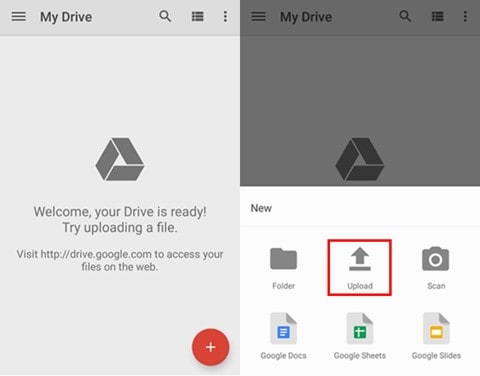
2. Use the local file manager to select a file.
3. Tap the Upload button.
Upload from Another App
Most apps that handle documents and other files will have a Share option. Alternatively, you can use the Share option in your native file manager app. Here’s how to use it:
1. Click Share when the document is open in the app. You can also select the document/file from the list of files and use the generic Share option.
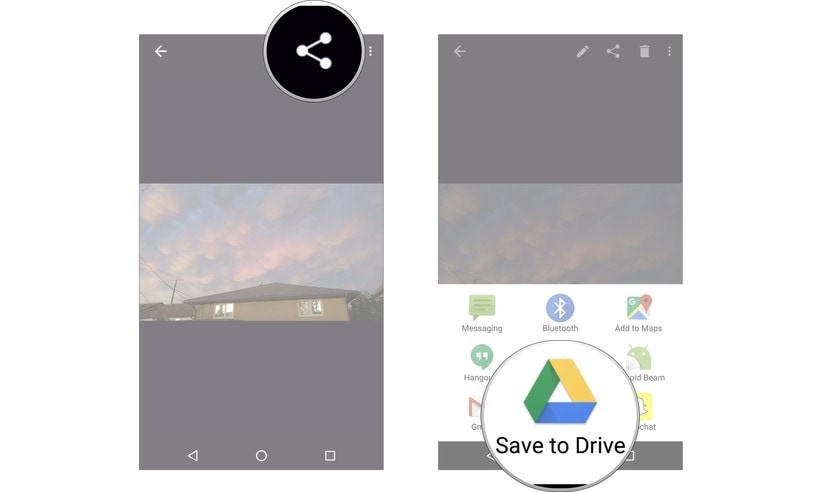
2. You will see Save to Drive as one of the share options. Tap that.
3. Next, if Drive prompts to for access to files and other content on your device, tap Allow in the pop-up notification.
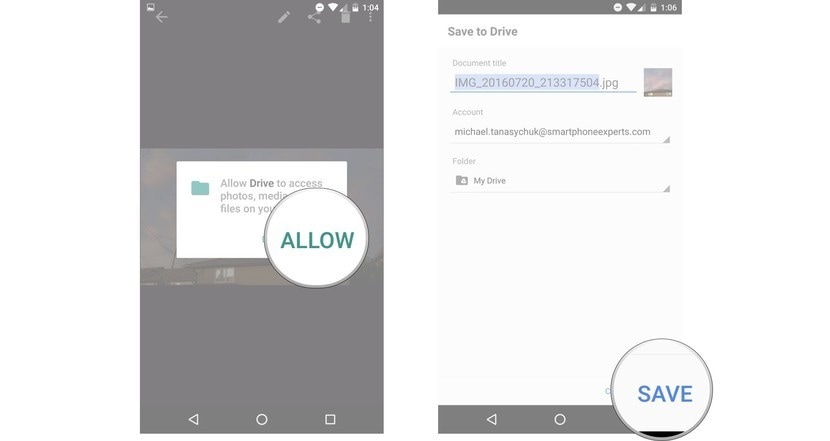
4. You can now change the file’s name if you need to before you tap Save.
What to Do After Saving Documents to Google Drive
Once your files are safely in the cloud, there are several operations you can execute from within Drive. The specific process might be different on desktop vs. mobile but the functionality is the same. Here are some of the things you can do:
- Open or Preview: Depending on the type of document, you can either open and view it or just preview it (no modifications possible)
- Download to device or desktop: You can download the file from another device or computer, but only if you’re signed in to the same Google account.
- Share the file with others: You can share files and folders using the Share function. A link will be generated, which you can copy or send directly via Gmail from Drive. You can also set permissions such as View, Comment, and Edit for each user or all users together.
- Move a File or Make a Copy: Files and folders can be moved to another Drive location within the same account. You can also make a copy if you need a duplicate of a file for any reason.
- Delete: Remove a file or folder from Drive with this option.
- Rename: Change the name of a file or folder
- More Actions: You can also publish a document to the web using an embed code or link, translate a document that’s editable, find and enable add-ons like PDF readers or media players
Learning how to save documents in Google Drive from different devices and in different ways makes it easy to access your files and folders no matter where you are or what device you’re using. However, Google Drive does have one major weakness - PDF documents. Although you can preview a PDF file in Drive, you can’t open and view it without a third-party add-on. If you’re looking for a cloud storage solution exclusively for PDF documents, the Wondershare PDFelement Cloud might be ideal for you. In addition to secure cloud storage, it also provides a built-in electronic signature platform for creating signatures, signing PDF documents, and sending them to others to collect their signatures.
How to Save Documents to Google Drive Alternative
Wondershare PDFelement Cloud is a PDF-based cloud storage service that comes with an integrated electronic signature solution to create e-signatures, e-sign documents, and send documents online for others to sign. The enterprise-grade security protocols protect your PDF files on the cloud and while in transit. Recipients are sent a secure link that they can use to upload a signature and apply to the document. They can also generate a new e-signature and sign their copy of the document before submitting it back to the sender. Neither the sender nor recipient needs to download or install anything. They can use the service on any device as long as it has a modern browser installed on it.
The Process for How to Save Documents to Wondershare PDFelement Cloud
1. Open a browser tab and sign up to Wondershare PDFelement Cloud for a free account. You can upgrade later if you need to send more documents for signing or if you need more than the default 5GB of free storage.

2. Once inside, click Upload Files and choose your PDFs from the local hard drive or device memory. If you have external storage devices hooked up to your computer, you can upload from there as well.
3. The files will be uploaded to PDFelement Cloud and will be listed under Recent Document Activity in the Home tab or in the main section of the Document Tab.
After you upload your PDF documents to Wondershare Cloud, you can do several operations, as listed below:
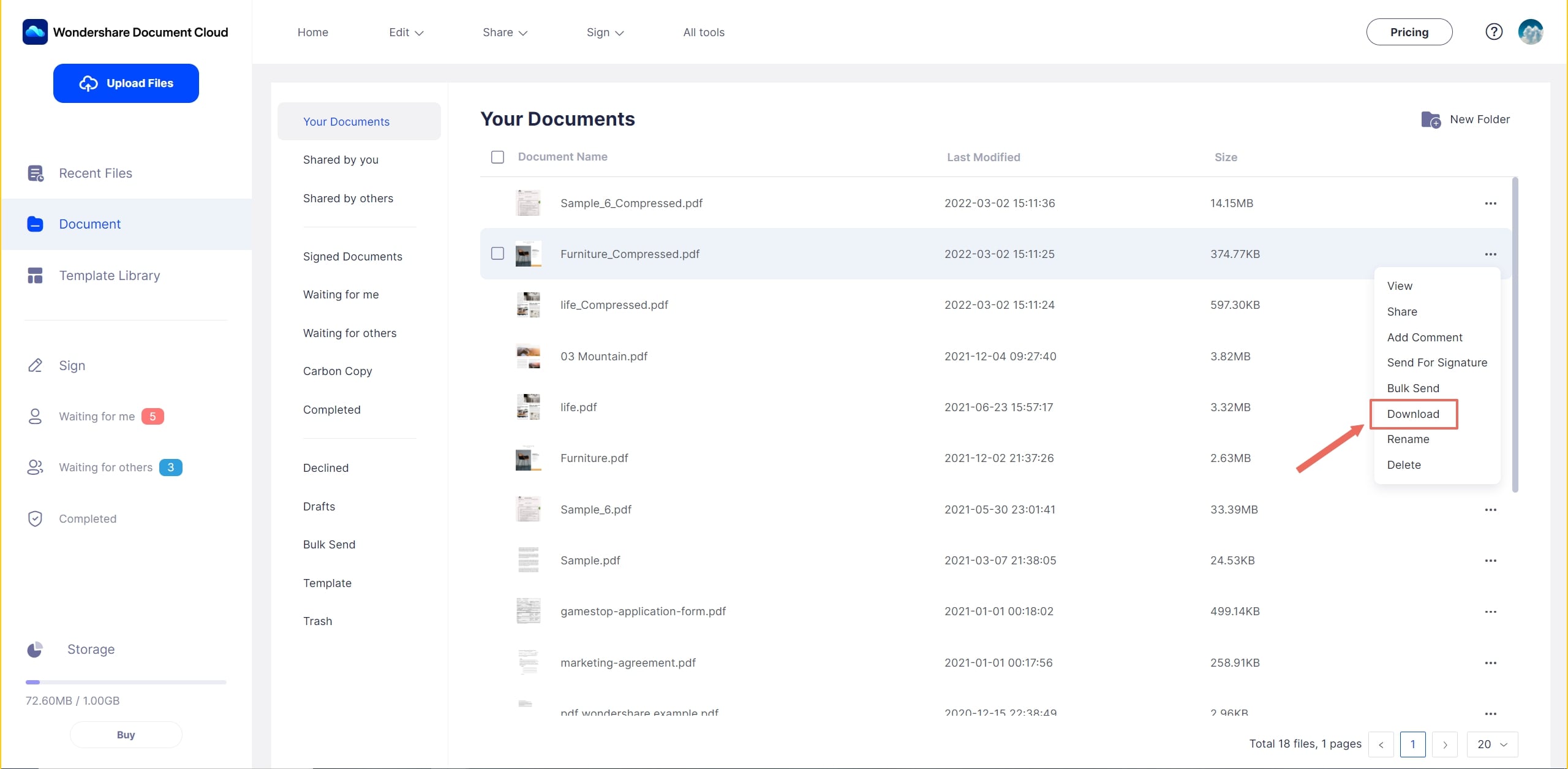
- Open the document - You can use the View option to open and read a document.
- Send for Signatures - The Request Signatures option in the Sign tab can be used when you need a single copy of a document to be signed by multiple signers or signatories; the Bulk Send operation sends an individual copy to each person on your list so they can sign separately and submit it back to you.
- Download to local memory - To save a file on your local drive or device, use the Download button and specify the destination folder.
- Delete - If you no longer need a particular file, you can hit Delete to remove it from PDFelement Cloud.
- Rename - You can assign a different name to a file in order to easily identify the contents of the PDF; for example - rename a PDF to February Invoice for Client XYZ to track it later on.
As you can see, Wondershare PDFelement Cloud is a powerful new way to store workflow documents and send them to others for signing in mere seconds no matter what your location or the device you’re using. But if you want the real power of PDF along with it, then consider using PDFelement Pro DC, which brings the best of desktop PDF editing and is integrated with PDFelement Cloud for storage and e-signing.
PDFelement Pro DC for Windows
Wondershare PDFelement Pro DC
Simplify your Workflow with the PDFelement Cloud.
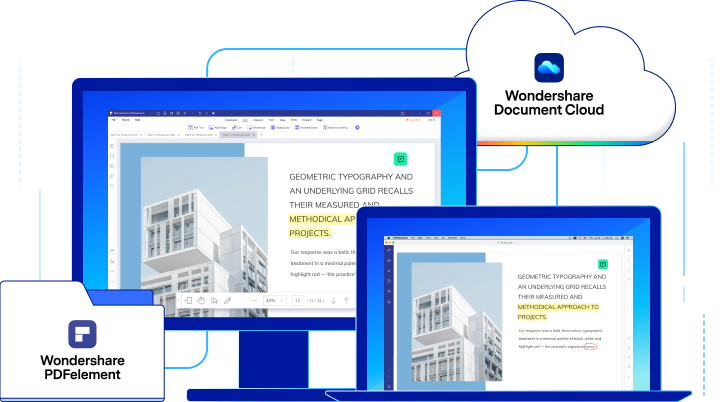
The latest Windows version of PDFelement Pro DC is a comprehensive document management tool that’s perfect for PDFs and other file types. The new interface is accompanied by redesigned iconography, improved ribbon-style toolbars, clearer menus, and blazing fast performance compared to earlier versions. It also has features that directly connect you with Wondershare PDFelement Cloud from your Windows computer. Here’s a list of offline and online features in PDFelement Pro DC:
Offline Features

- Document editing - Edit any content in a PDF document as easily as editing a DOCX file in MS Word.
- Conversions - Easily convert over 300 file types to create PDFs while maintaining complete content integrity (layouts, alignment, font styles, etc.) You can also convert from PDF in several types of files like Word, Excel, .txt, HTML, ePUB, image files, etc.
- Annotations - Markup your PDFs like a Pro and communicate your thoughts concisely with a full range of review and commenting tools.
- PDF security - Protect files with password-based encryptions with the toughest algorithms used by banks and large corporations.
- Form handling - Creating a form from a template or blank document, filling a form, signing it, extracting data from it, or converting a non-editable document to an editable PDF form are all very simple actions in PDFelement Pro DC.
- Advanced file and page management - Organize your PDF workflows by merging or splitting files or specific page ranges, reorganizing pages, and more.
- Advance text recognition or OCR to convert scanned files into PDFs that can be searched or edited.
- Batch Process - A great way to get through massive workloads at the click of your mouse - convert, encrypt, etc. with speed and accuracy.
Online Features
● Work on a PDF and upload it directly to Wondershare PDFelement Cloud
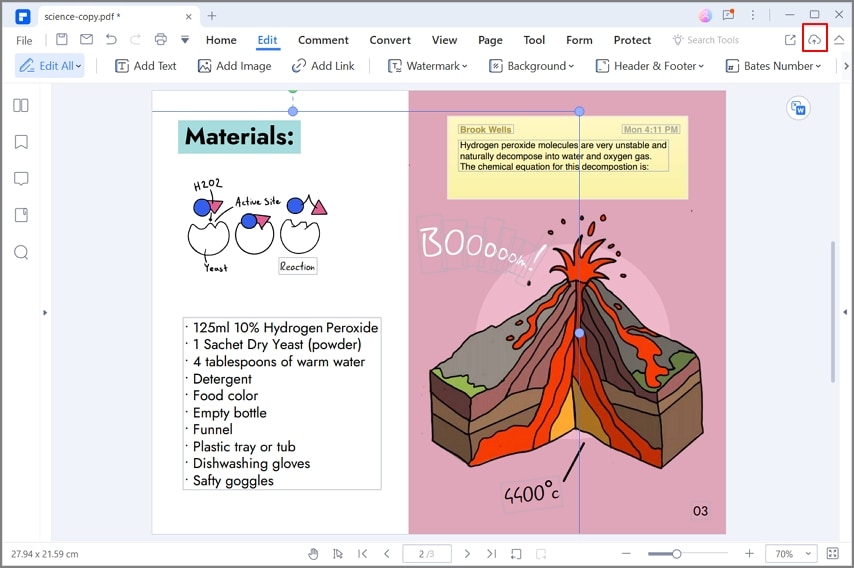
After editing a saving a PDF file locally, you can click Share → Wondershare Cloud to open the cloud storage service in a new tab. The document will be uploaded and stored there, and you can see it listed in the Document tab or in the Recent Document Activity of the Home tab.
● Download a PDF from the cloud for offline editing in PDFelement
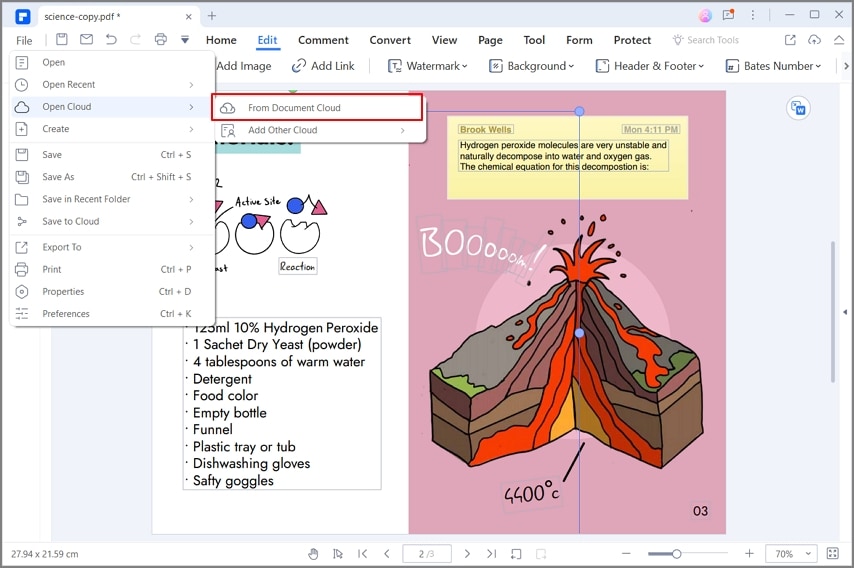
If you need to edit a document that you uploaded to PDFelement Cloud earlier, simply click the Open → File menu item and choose From Wondershare Cloud to fetch the file and automatically open it in PDFelement.
● Prepare a document and send it to others for signing
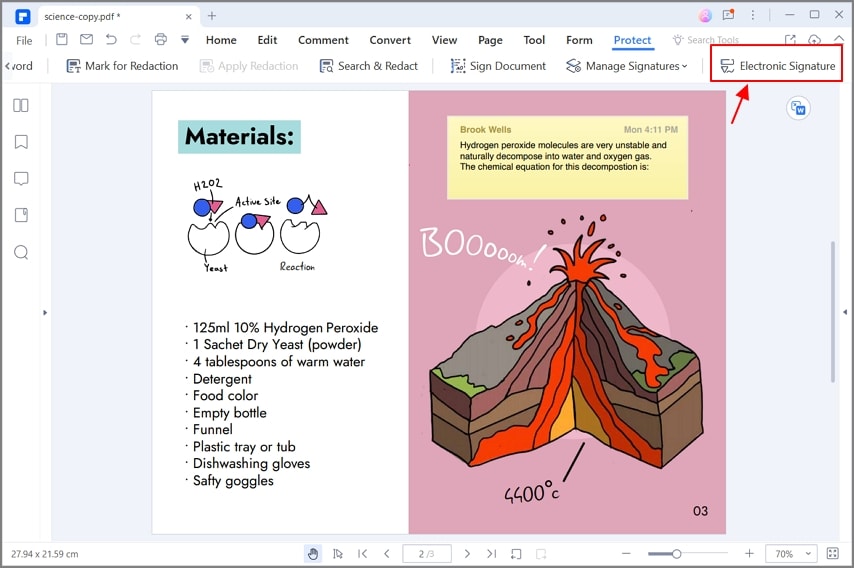
When your edited document is ready to be signed, click the Electronic Signature button beneath the Protect tab. This will take you to the Sign tab of Wondershare PDFelement Cloud, from where you can initiate one of the two e-signing options.
Final Thoughts about Productivity
It is vital for every business to continually look for ways to enhance the productivity of their employees and become more efficient as an organization. Just as learning how to save documents in Google Drive can make your official files accessible by all authorized users from any location, Wondershare PDFelement Cloud can do the same for PDF files.
Moreover, the online electronic signature feature means your field teams (sales, procurement, etc.) can send documents and get signatures while on-site with the client or vendor. That translates to faster time to revenue realization and smoother workflows because your projects won’t be delayed because someone is on holiday or working from a different location or even another country.
Although Wondershare PDFelement Cloud is designed as a standalone service, combining it with the robust document management features of PDFelement in the new PDFelement Pro DC gives you end-to-end control over all your PDF workflows and signature collection needs. This multi-terminal or device-agnostic nature of the PDFelement Cloud platform gives your teams the freedom to work from anywhere in an efficient and highly productive manner. Try Wondershare PDFelement Cloud and unleash the power of the cloud, or use PDFelement Pro DC to get the most out of the PDF experience.



